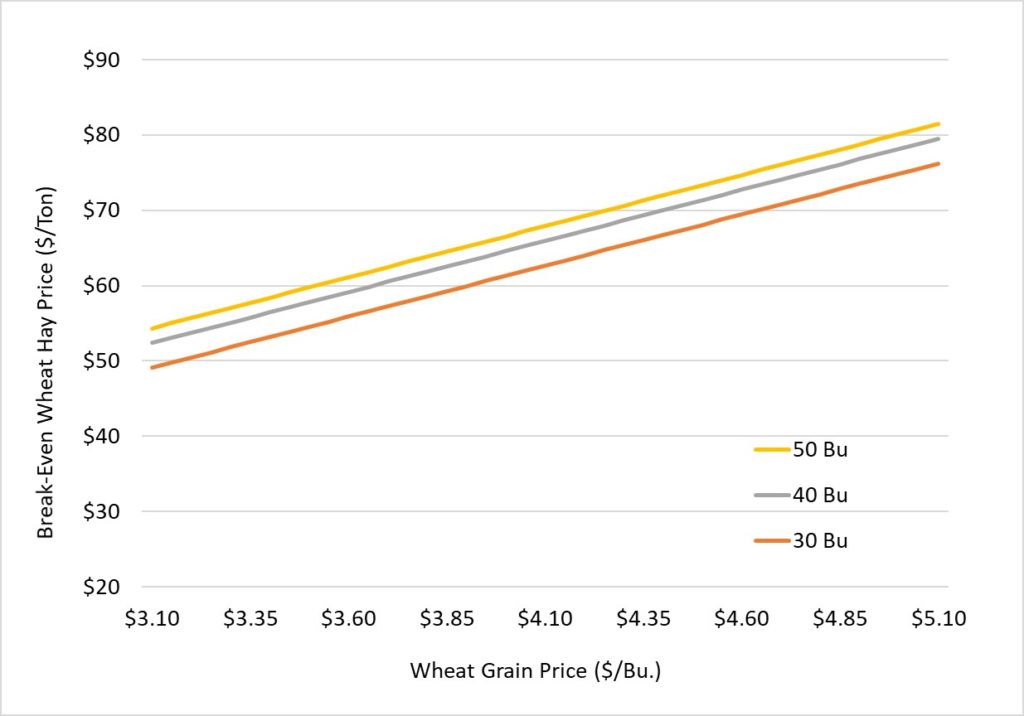by Reagan Noland, Extension Agronomist, San Angelo | 325-657-7330 | reagan.noland@ag.tamu.edu
Bill Thompson, Extension Economist, San Angelo | 325-657-7306 | w-thompson@tamu.edu
Clark Neely, Small Grains Extension Specialist, College Station | 979-862-1412 | cbneely@tamu.edu
Early spring is an important time to assess the wheat crop and determine end goals and marketing options that will maximize revenue. Recent declines in wheat grain price may make positive returns above total cost impossible. This changes the near-term objective to maximizing revenue per acre, relative to additional agronomic inputs and harvest costs. Growers may decide between managing for and harvesting the grain crop or cutting and baling hay. This choice can influence management factors, such as fungicide or irrigation application(s) and coordinating harvest and marketing plans. Here, we present a tool to establish the minimum (break-even) wheat hay price that will generate the same level of net revenue as a grain crop: Wheat Grain vs. Hay Decision Aid.
Estimates of both hay and grain yield of a given wheat crop are needed in order to make this assessment. Many growers may have a relative idea of how a given crop will yield, based on prior experience with the land, environment, and inputs. There are also methods to predict grain yield based on tiller or head counts and available water and nutrients. Click here for a technical approach to estimating wheat grain yield. Hay yield potential can be predicted from expected grain yield based on a standard harvest index. For example, grain makes up approximately 40% of the total biomass in a mature wheat crop. This value can be used with anticipated grain yield to predict total crop tonnage.
The analysis presented here is replicated for different estimated grain yields and farm level wheat prices; however, yields, prices, and other inputs can be entered into the calculator (link below) to generate a break-even wheat hay price specific to your operation. The analysis assumes that most all production costs have been incurred, and these are deemed to be sunk costs. This means that we do not need to consider prior production costs in order to compare what happens from this point forward. The default remaining costs include at least one fungicide application and harvest expenses. Table 1 summarizes the remaining costs used in calculating the break-even wheat hay prices. These also can be manipulated in the calculator to reflect a given situation.
Table 1. Estimates remaining production and harvest costs
| Input | Cost | Unit |
| Fungicide Treatment | ||
| Chemical | $4.00 | Acre |
| Application | $5.00 | Acre |
| Grain Harvest | ||
| Combine | $23.00 | Acre |
| Hauling | $0.20 | Bushel |
| Overage Charge (Over 24 Bu.) | $0.23 | Bushel |
| Forage Harvest | ||
| Swath | $15.00 | Acre |
| Bale (1100 lbs) | $17.50 | Bale |
Hay Yield Estimates
The method applied to predict hay yield is based off of a grain yield estimate. Furthermore, each estimate is based on other assumptions. Therefore, applications of these predictions should be approached with caution and understanding that they are ballpark figures with an almost certain margin of error.
Input variables for the hay yield estimate include potential grain yield and growth stage at hay harvest. A harvest index (HI) of 0.4 is assumed at the peak of biomass production (within a few weeks of harvest). This means that grain makes up 40% of the total biomass. Estimated yields for earlier growth stages are assumed as percentages of the total yield potential (Figure 2). Table 2 highlights the impact of predicted grain yield and growth stage on estimated hay yield. Remember that forage nutritive value declines as wheat matures. While harvesting earlier will yield less tonnage, the hay will have greater nutritive value per ton, and should be marketed at a greater price.

Figure 1. Small grain nutrient uptake and biomass accumulation relative to growth stage (Malhi et al., 2006)
Table 2. Estimates hay yield (lbs/acre) by grain yield potential and growth stage at cutting
| Growth stage and percent of total hay yield potential | ||||
| Grain Yield Potential(Bu/Acre) | Boot
(62%) |
Heading
(76%) |
Milk (89%) |
Dough (100%) |
| — lbs/acre— | ||||
| 30 | 2,720 | 3,340 | 3,930 | 4,420 |
| 40 | 3,630 | 4,450 | 5,240 | 5,900 |
| 50 | 4,540 | 5,560 | 6,550 | 7,370 |
Break-Even Price Calculation
A gross revenue for grain per acre is estimated as potential grain yield multiplied by anticipated farm level price (futures price adjusted for local basis). (Results from an ongoing basis monitoring project can be found here.) This gross return is reduced by additional costs yet to be incurred (fungicide application, grain harvest, and other costs) to calculate a partial net return. The difference in production and harvest cost between grain and hay is added to the grain revenue to establish a total value per acre that needs to be matched by the hay crop. This value is then divided by the anticipated forage yield to identify the break-even price per unit weight.
Management Implications
Figure 2 shows the break-even hay price relative to grain price at three yield levels, using the default values for remaining costs. For example, if a grower will receive $4.15/bu for wheat, and they expect to make 40 bushels per acre, or cut hay at the dough stage, then a hay price greater than $67 per ton would justify cutting and selling hay rather than harvesting grain. When assessing these economic thresholds, it is important to consider the expected nutritive value of the hay, and how this may influence the selling price. Harvested earlier, hay will have greater nutritive value, and should bring a higher price per ton. If the wheat is cut after heading, many hay buyers may pay more for beardless wheat. The standards and expectations of the buyer should be established prior to harvest.
An additional cost consideration is that harvesting hay removes more nutrients from the land than harvesting grain, and the economic value of these nutrients should also be regarded. At 12% grain protein, a 40-bushel wheat crop removes ~40 lbs N per acre in the harvested grain. The same crop would yield about 5190 lbs of hay if cut at the dough stage. At 10% protein, this hay crop would remove ~83 lbs N per acre. This means that 43 more lbs of N would be removed with the hay versus harvesting only the grain. If fertilizer N costs ~$0.40 per pound (depending on the source), then the nutrient replacement cost is ~$17 per acre greater for hay than grain. Nutrient replacement costs are not assumed in the calculator, as fertilizer costs and nutrient levels in the soil can vary widely, as well as farm objectives or plans for the subsequent crop. Estimated values for nutrient replacement can be entered in the “Additional Cost” fields if desired.
This calculator is intended to provide insight to a comparison of economic opportunities. Values generated through this tool should be considered as “ballpark” estimates, with an understanding that several assumptions are used to produce estimated break-even hay prices. The accuracy of these estimates are also subject to future (unknown) environmental conditions. A producer’s ability to effectively market and move wheat hay is perhaps the most important consideration when assessing these values. Hay marketing opportunities are generally subject to local demand. If a grower has a reliable outlet to sell hay in a timely fashion, then estimates of break-even hay prices are more likely to have immediate implications on their management decisions. If a suitable outlet is not readily available, then growers should carefully consider whether cutting hay will be profitable. This tool does not assess the economics of storing hay, and long-term demands are difficult to predict.
Access the calculator here: Wheat Grain vs. Hay Decision Aid
Reference
Malhi, S.S., A.M. Johnston, J.J. Schoenau, Z.H. Wang, and C.L. Vera. 2006. Seasonal biomass accumulation and nutrient uptake of wheat, barley and oat on a Black Chernozem soil in Saskatchewan. Canadian Journal of Plant Science. 86: 1005–1014. DOI: 10.4141/P05-116

Reagan Noland
Assistant Professor & Extension Agronomist
Email:
reagan.noland@tamu.edu
Phone:
(325) 657-7330
Office:
San Angelo, Texas
